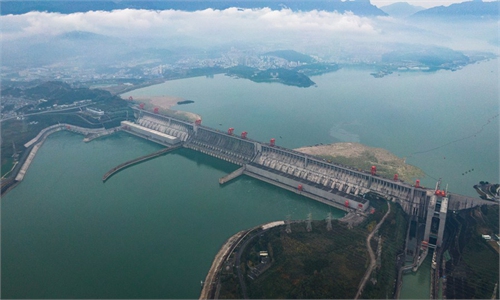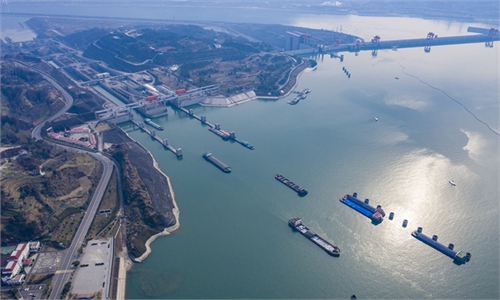Three Gorges Dam dedicated to fish, plant conservation since before construction, as ecology and dam building go hand in hand
As the mammoth Three Gorges project contributes hugely to China's pursuit of low-carbon development by making great use of renewable hydropower, it is trying all possible means to reduce its impact on the ecological environment - as a result, a situation is forming where most local fish and plant species are recovering and some are having a bigger population than before the project was built.
Experts reached by the Global Times did not shy away from the ecological impacts of the Three Gorges Dam, such as it changing the habits of some fish species in the Yangtze River, but they pointed out that these impacts are not necessarily entirely negative for the species, and the project and local governments have been trying many possible means of aid, like releasing artificially cultivated breeds into the river, to increase their population in the wild.

Proactive restoration actions
10,000 Chinese sturgeons, known as the "panda in the water" due to the ancient history of the species, recently left their captive breeding environments and dived into the Yangtze River in Yichang, Central China's Hubei Province, where they were expected to travel downstream to enter the ocean and eventually return to the Yangtze again to spawn after 10 years.
As the flagship species in the Yangtze River, the changes of survival conditions for Chinese sturgeon have mirrored the fate of other fish and plant species in the Three Gorges Reservoir area.
The Three Gorges project is China's largest water conservancy project, it intercepted the Yangtze River in 1997 and impounded water to its designed operating level of 175 meters in 2010, creating a 600-kilometer-long giant reservoir in the Chongqing-Yichang section of the Yangtze River.
"The terraced reservoir's altered hydrological conditions and blocked migratory pathways of some fish, which has affected the aquatic living resources in the reservoir to varying degrees," an expert surnamed Zhao from the Institute of Hydroecology, under the Ministry of Water Resources and the Chinese Academy of Sciences, told the Global Times.
Some experts estimated that in 2005, the number of Chinese sturgeon migrating from the sea to lay eggs had dropped from 2,000 in 1985 to 500.
Zhao's research team found that the number of fish species in the Three Gorges Reservoir area decreased from the 1980s to 2015. "This phenomenon is closely related to overfishing in the Yangtze River, but is also inevitably linked to the dam's impoundment operation," Zhao said.
In order to protect the Yangtze biodiversity, the China Three Gorges Corporation (CTG) has established two institutes dedicated to researching and monitoring the animal and vegetation, respectively, especially the protected species.
Du Hejun, head of the Species Conservation Technology Section at Three Gorges Corp Yangtze River Rare Fish Conservation Center, one of the institutes, said some fish in the Yangtze River may have changed their living habits since to the reservoir's formation.
"The reservoirs have also provided a more diverse habitat for fish; fish with less stringent hydrological requirements have had their populations gradually recover after adapting to the new environment. This, coupled with measures such as long-term fishing bans and artificial breeding and releasing activities, has further increased the diversity of fish species in the reservoir area," Du told the Global Times. Du noted that over the past decades, CTG has continuously promoted the thematic research on the ecological impact of the project, mastered the core technology of species protection such as the full artificial breeding of Chinese sturgeon, and established a full-cycle Chinese sturgeon protection system including breeding and migration monitoring after release.

Du noted that from 2011 to 2020, the Three Gorges Dam has created 14 artificial "flood peaks." In the 2019 regulation, the total spawning size of the four major Chinese carp species in the Yidu section of the Yangtze River was up to approximately 3 billion, which was already comparable to the level before the dam was constructed.
"The industrial construction and ecological protection of the Three Gorges Project were carried out simultaneously," Huang Guiyun, deputy director of the Yangtze River Rare Plant Research Institute of CTG, said.
Huang noted that faced with the possibility of some wild plants and fish becoming extinct after the Three Gorges Dam impoundment, since 1992, the Chinese government had already begun to organize researchers to investigate the distribution of rare plants and fish and carry out targeted protection work.
"By the end of 2018, all 560 species of potentially extinct cherished plant species listed on the previous environmental assessment report had been effectively protected with none going extinct. As of December 2020, the institute had protected and bred a cumulative total of 1,181 species and 180,000 rare plants of the Yangtze River," she added.
At present, the institute also conducts ecological restoration research in the water-level-fluctuation zone of the Three Gorges Dam, building a 17,500 square meters' experimental area to allow the unique rare plant seedlings to be bred in the laboratory and then migrated to their natural environments smoothly.
Half of the year in the field and the rest in the laboratory has become the normal routine for the research team lead by Huang. "Compared to the natural competition for survival of the fittest, vegetation protection in the Three Gorges Reservoir area has actually done better with human intervention than before the dam was built," she added.
China built the magnificent Three Gorges Dam, which is a historic environmental protection project that not only successfully tamed floods along the Yangtze River, but also made important contribution to the country realizing capping carbon emissions and promoting green energy, Moin ul Haque, the Pakistani Ambassador to China, told the Global Times when attending the Chinese sturgeon release activity in Yichang.
According to the estimates of the Chinese Academy of Engineering, the multi-year average flood control benefit of the Three Gorges project stands at approximately 8.8 billion yuan ($1.35 billion).
"The flood control capability of the Three Gorges project has given the Yangtze River economic belt a strong ecological barrier, providing tens of millions of residents a safe living and developmental environment. It has also enabled the ecological order of the Yangtze River basin to move toward a virtuous circle," Zhong Zhiyu, chief engineer of Changjiang Water Resources Committee, told the Global Times.
In terms of energy-saving and emission reduction, the Three Gorges project is the "green engine" for building a clean and low-carbon China, Zhong said.
Statistics from CTG revealed that the Three Gorges Power Station produced 111.8 billion kWh of clean electricity in 2020, which can supply about 8 months-worth of electricity consumption of Shanghai (based on 2019 electricity consumption data).
It can replace about 34.39 million tons of standard coal-generated electricity and reduce about 94.02 million tons of carbon dioxide emissions, which is equivalent to planting 370,000 hectares of broad-leaf forests.
The Three Gorges project reflects the gradual transformation of China and its people from a desire for food and clothing to looking forward to ecological environmental protection over the years, Zhong noted.
"In the past, many people could not accept the development of hydropower, but today, we are all proud of the Three Gorges Dam, which has inspired us to be more active to restore the ecology of the Yangtze River," Yuan Ximei, vice-chairman of the Three Gorges Ant Workers (TGAW), an NGO in Yichang that has long been committed to protecting the Three Gorges' ecological environment, told the Global Times.
In the past five years since its establishment, the TGAW has grown into a volunteer team with nearly 350 members, and has organized 661 environmental activities and collected nearly 1,000 tons of trash along the Three Gorges.
"We also hope to put our environmental footprints on the Three Gorges side, guarding our green hills and clear waters together with this major national project," Yuan said.
Experts reached by the Global Times did not shy away from the ecological impacts of the Three Gorges Dam, such as it changing the habits of some fish species in the Yangtze River, but they pointed out that these impacts are not necessarily entirely negative for the species, and the project and local governments have been trying many possible means of aid, like releasing artificially cultivated breeds into the river, to increase their population in the wild.

The beautiful scenery along the Three Gorges during spring in Zigui county of Yichang city, central China's Hubei Province Photo: IC
Proactive restoration actions
10,000 Chinese sturgeons, known as the "panda in the water" due to the ancient history of the species, recently left their captive breeding environments and dived into the Yangtze River in Yichang, Central China's Hubei Province, where they were expected to travel downstream to enter the ocean and eventually return to the Yangtze again to spawn after 10 years.
As the flagship species in the Yangtze River, the changes of survival conditions for Chinese sturgeon have mirrored the fate of other fish and plant species in the Three Gorges Reservoir area.
The Three Gorges project is China's largest water conservancy project, it intercepted the Yangtze River in 1997 and impounded water to its designed operating level of 175 meters in 2010, creating a 600-kilometer-long giant reservoir in the Chongqing-Yichang section of the Yangtze River.
"The terraced reservoir's altered hydrological conditions and blocked migratory pathways of some fish, which has affected the aquatic living resources in the reservoir to varying degrees," an expert surnamed Zhao from the Institute of Hydroecology, under the Ministry of Water Resources and the Chinese Academy of Sciences, told the Global Times.
Some experts estimated that in 2005, the number of Chinese sturgeon migrating from the sea to lay eggs had dropped from 2,000 in 1985 to 500.
Zhao's research team found that the number of fish species in the Three Gorges Reservoir area decreased from the 1980s to 2015. "This phenomenon is closely related to overfishing in the Yangtze River, but is also inevitably linked to the dam's impoundment operation," Zhao said.
In order to protect the Yangtze biodiversity, the China Three Gorges Corporation (CTG) has established two institutes dedicated to researching and monitoring the animal and vegetation, respectively, especially the protected species.
Du Hejun, head of the Species Conservation Technology Section at Three Gorges Corp Yangtze River Rare Fish Conservation Center, one of the institutes, said some fish in the Yangtze River may have changed their living habits since to the reservoir's formation.
"The reservoirs have also provided a more diverse habitat for fish; fish with less stringent hydrological requirements have had their populations gradually recover after adapting to the new environment. This, coupled with measures such as long-term fishing bans and artificial breeding and releasing activities, has further increased the diversity of fish species in the reservoir area," Du told the Global Times. Du noted that over the past decades, CTG has continuously promoted the thematic research on the ecological impact of the project, mastered the core technology of species protection such as the full artificial breeding of Chinese sturgeon, and established a full-cycle Chinese sturgeon protection system including breeding and migration monitoring after release.

Workers carefully transfer Chinese sturgeons at the release site on April 10 in Yichang, Central China's Hubei Province. Photo: Li Hao/GT
To create an aquatic environment suitable for fish breeding, the CTG has been carrying out a special "biological regulation" project for many years, creating artificial "flood peaks" by adjusting the scheduling of the Xiluodu-Xiangjiaba-Three Gorges Dams to meet the rising water conditions required for fish spawning in the Yangtze River.Du noted that from 2011 to 2020, the Three Gorges Dam has created 14 artificial "flood peaks." In the 2019 regulation, the total spawning size of the four major Chinese carp species in the Yidu section of the Yangtze River was up to approximately 3 billion, which was already comparable to the level before the dam was constructed.
"The industrial construction and ecological protection of the Three Gorges Project were carried out simultaneously," Huang Guiyun, deputy director of the Yangtze River Rare Plant Research Institute of CTG, said.
Huang noted that faced with the possibility of some wild plants and fish becoming extinct after the Three Gorges Dam impoundment, since 1992, the Chinese government had already begun to organize researchers to investigate the distribution of rare plants and fish and carry out targeted protection work.
"By the end of 2018, all 560 species of potentially extinct cherished plant species listed on the previous environmental assessment report had been effectively protected with none going extinct. As of December 2020, the institute had protected and bred a cumulative total of 1,181 species and 180,000 rare plants of the Yangtze River," she added.
At present, the institute also conducts ecological restoration research in the water-level-fluctuation zone of the Three Gorges Dam, building a 17,500 square meters' experimental area to allow the unique rare plant seedlings to be bred in the laboratory and then migrated to their natural environments smoothly.
Half of the year in the field and the rest in the laboratory has become the normal routine for the research team lead by Huang. "Compared to the natural competition for survival of the fittest, vegetation protection in the Three Gorges Reservoir area has actually done better with human intervention than before the dam was built," she added.

Several temperature-controlled Chinese sturgeon breeding ponds in Three Gorges Corp Yangtze River Rare Fish Conservation Center. Photo:Li Hao/GT
Giving back to natureChina built the magnificent Three Gorges Dam, which is a historic environmental protection project that not only successfully tamed floods along the Yangtze River, but also made important contribution to the country realizing capping carbon emissions and promoting green energy, Moin ul Haque, the Pakistani Ambassador to China, told the Global Times when attending the Chinese sturgeon release activity in Yichang.
According to the estimates of the Chinese Academy of Engineering, the multi-year average flood control benefit of the Three Gorges project stands at approximately 8.8 billion yuan ($1.35 billion).

GT
"The flood control capability of the Three Gorges project has given the Yangtze River economic belt a strong ecological barrier, providing tens of millions of residents a safe living and developmental environment. It has also enabled the ecological order of the Yangtze River basin to move toward a virtuous circle," Zhong Zhiyu, chief engineer of Changjiang Water Resources Committee, told the Global Times.
In terms of energy-saving and emission reduction, the Three Gorges project is the "green engine" for building a clean and low-carbon China, Zhong said.
Statistics from CTG revealed that the Three Gorges Power Station produced 111.8 billion kWh of clean electricity in 2020, which can supply about 8 months-worth of electricity consumption of Shanghai (based on 2019 electricity consumption data).
It can replace about 34.39 million tons of standard coal-generated electricity and reduce about 94.02 million tons of carbon dioxide emissions, which is equivalent to planting 370,000 hectares of broad-leaf forests.
The Three Gorges project reflects the gradual transformation of China and its people from a desire for food and clothing to looking forward to ecological environmental protection over the years, Zhong noted.
"In the past, many people could not accept the development of hydropower, but today, we are all proud of the Three Gorges Dam, which has inspired us to be more active to restore the ecology of the Yangtze River," Yuan Ximei, vice-chairman of the Three Gorges Ant Workers (TGAW), an NGO in Yichang that has long been committed to protecting the Three Gorges' ecological environment, told the Global Times.
In the past five years since its establishment, the TGAW has grown into a volunteer team with nearly 350 members, and has organized 661 environmental activities and collected nearly 1,000 tons of trash along the Three Gorges.
"We also hope to put our environmental footprints on the Three Gorges side, guarding our green hills and clear waters together with this major national project," Yuan said.
